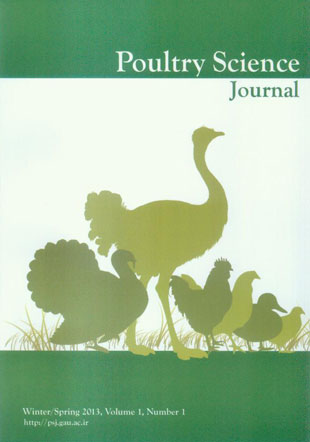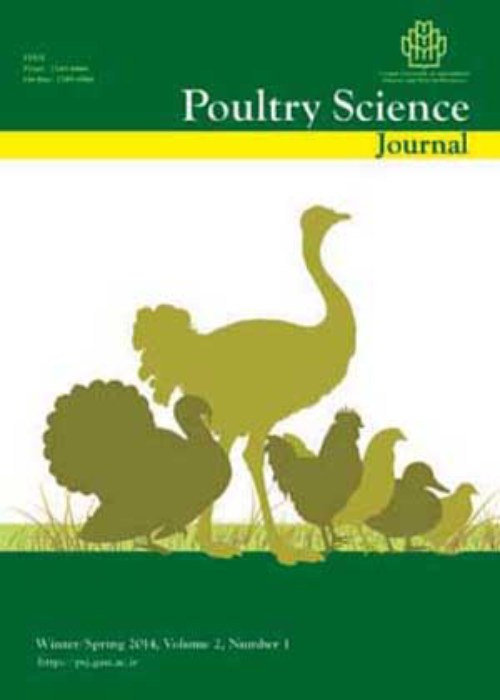فهرست مطالب

Poultry Science Journal
Volume:1 Issue: 1, Winter-Spring 2013
- تاریخ انتشار: 1392/06/29
- تعداد عناوین: 6
-
-
Pages 1-11The Japanese and English White quails are widespread strains and belongs to the Galliformes order, Phasianidae family, Coturnix genus and Japonica species. These birds are likely to be well-adapted to the hard conditions and resistance to diseases as it has attained economic importance as an agricultural species. In the current study, the genetic variation of Japanese and English White quail populations were studied. Frequency of polymorphic loci, polymorphic information content, heterozygosity, Shannon''s information index, number of observed and effective alleles were assessed using 4 microsatellite markers with high polymorphic information content value (GUJ0034, GUJ0049, GUJ0080 and GUJ0097). The Blood samples were collected randomly from 50 Japanese quails and 50 English White quails rearing in the research center of Gorgan University of Agricultural Sciences and Natural Resources. The genomic DNA was extracted using DIAtom DNA Prep 100 kit, and its quality and quantity were determined using electrophoresis gel and spectrophotometery methods. The PCR reactions were successfully performed with four microsatellite markers. The results based on the chi - square and likelihood ratio tests showed a significant deviation from Hardy-Weinberg equilibrium. The means of genetic diversity parameters such as number of effective alleles, the number of observed alleles, the expected and observed heterozygosity, Shannon''s information index and PIC in quail populations were 4.78±0.37, 7.50±0.57, 0.79±0.02, 0.60±0.16, 1.73±0.05 and 0.76±0.02 respectively. The results of the current study showed that the investigated quail populations have a relatively high genetic diversity with respect to the applied microsatellite markers and confirmed prior study’s findings on the ability of microsatellite markers in investigating genetic diversity.Keywords: Broiler, Housing Construction cost, Performance, Blood parameters, Carcass variables
-
Pages 13-22The aim of this study was to examine whether the secreted fluid from the uterus influences the survival and fertilization capacity of fowl sperm in the hen oviduct. Hens with either regular uterine fluid secretion or irregular uterine fluid secretion were artificially inseminated through the transfer of sperm into the uterus. Twenty-four hours after artificial insemination, 3 hens with regular uterine fluid secretion and 3 hens with irregular uterine fluid secretion were killed, and the utero-vaginal junction and infundibular sperm storage tubules were observed for the presence of sperm. There was no difference (P>0.05) in the fill rate of either the utero-vaginal junction sperm storage tubules or the infundibular sperm storage tubules between hens with regular or irregular uterine fluid secretion. However, the sperm transferred into hens with regular uterine fluid secretion had a longer lifespan and fertilization ability than the counterpart group (P<0.05). In conclusion, these study results suggest that regular fluid secretion from the hen uterus may sustain the longevity and fertilization ability of fowl sperm in the oviduct.Keywords: Fertilization ability, Sperm survival, Uterine fluid
-
Pages 23-31This research was carried out to investigate the effects of various levels of dietary organic selenium supplementation (0,0.1, 0.2 and 0.3 mg/Kg) on reproductive traits of rooster. Semen was collected using abdominal massage and samples were mixed together. Sperm characteristics including percentage of motile, viable and abnormal sperms were assessed. This experiment was carried out based on a completely randomized design. Results showed that the organic selenium supplementation had significant effects on sperm motility and viability in liquid condition (P0.05). In conclusion, the use of organic selenium supplementation (0.3 mg/Kg) in diet of roostercould be recommended to improve semen quality.Keywords: Supplementation, Organic selenium, Rooster, Sperm, Motility
-
Pages 33-41The present study was carried out to investigate the polymorphism of intron 3 to exon 3 of prolactin gene containing 24 bpindel at nucleotide position (np) 358 and its association with some reproductive traits in Japanese quail. These traits consisted of weight (WSM) and age at sexual maturity (ASM), mean egg weight at 2nd, 4th, 6th, and 2-6th weeks (MEW), and the number of eggs during the 2nd, 4th, 6th, and 2-6th weeks of laying period (EN). Blood samples of 194 Japanese quail at 13wk of age were collected randomly. DNA was extracted from blood samples and amplified. The association of prolactin genotypes with reproductive traits was analyzed using the general linear model procedure of SAS software. A 24-bp indel[insertion (I) or deletion (D)] at np358 was identified. Based on the results obtained, the frequency of I and D alleles were 0.52 and 0.48, respectively. Frequencies of II, ID and DD genotypes were 0.10, 0.85 and 0.05, respectively. Genotypes II and ID were significantly associated with increased EN (P0.05). The results showed that prolactin gene polymorphism could be used to improve egg production in Japanese quail through marker-assisted selection.Keywords: Acidified Sodium Chlorite, Energy, Enzyme, Microbial load
-
Pages 43-52A total number of 5520 female and 480 male breeders (Arbor Acres plus) at 42wks of age were used in a 10-week-trial to investigate the effect of an enzyme complex on the quality and quantity of egg production as well as hatchability of broiler breeders fed a corn-soybean meal diet. There were two dietary treatment groups: a control group fed on a corn-soybean based diet, and the multi-enzyme group that received the same diet plus an enzyme complex including xylanase, amylase, protease, phytase, ß- glucanase, hemicellulase, and pectinase. Results showed that egg production rate and egg mass were numerically increased as a result of enzyme supplementation and differences between the treatment groups were significant at week 46 (P<0.05). Hatchability was not influenced by supplementing multi-enzyme mixture in the diet. The proportion of cracked and broken eggs was significantly (P<0.05) improved after using muti-enzyme supplementation in the diet of breeders. In conclusion, egg production and egg mass were increased as a result of multi-enzyme preparation. Significant improvements achieved in egg shell quality led to a greater number of eggs for hatching, though hatchability itself, was not improved by multi-enzyme supplementation.Keywords: Broiler breeders, Enzyme supplement, Hatchability, Performance
-
Pages 53-62The Japanese and English White quails are widespread strains and belongs to the Galliformes order, Phasianidae family, Coturnix genus and Japonica species. These birds are likely to be well-adapted to the hard conditions and resistance to diseases as it has attained economic importance as an agricultural species. In the current study, the genetic variation of Japanese and English White quail populations were studied. Frequency of polymorphic loci, polymorphic information content, heterozygosity, Shannon''s information index, number of observed and effective alleles were assessed using 4 microsatellite markers with high polymorphic information content value (GUJ0034, GUJ0049, GUJ0080 and GUJ0097). The Blood samples were collected randomly from 50 Japanese quails and 50 English White quails rearing in the research center of Gorgan University of Agricultural Sciences and Natural Resources. The genomic DNA was extracted using DIAtom DNA Prep 100 kit, and its quality and quantity were determined using electrophoresis gel and spectrophotometery methods. The PCR reactions were successfully performed with four microsatellite markers. The results based on the chi - square and likelihood ratio tests showed a significant deviation from Hardy-Weinberg equilibrium. The means of genetic diversity parameters such as number of effective alleles, the number of observed alleles, the expected and observed heterozygosity, Shannon''s information index and PIC in quail populations were 4.78±0.37, 7.50±0.57, 0.79±0.02, 0.60±0.16, 1.73±0.05 and 0.76±0.02 respectively. The results of the current study showed that the investigated quail populations have a relatively high genetic diversity with respect to the applied microsatellite markers and confirmed prior study’s findings on the ability of microsatellite markers in investigating genetic diversity.Keywords: Genetic variation, Japanese quail, English White, Microsatellite markers, Heterozygosity


